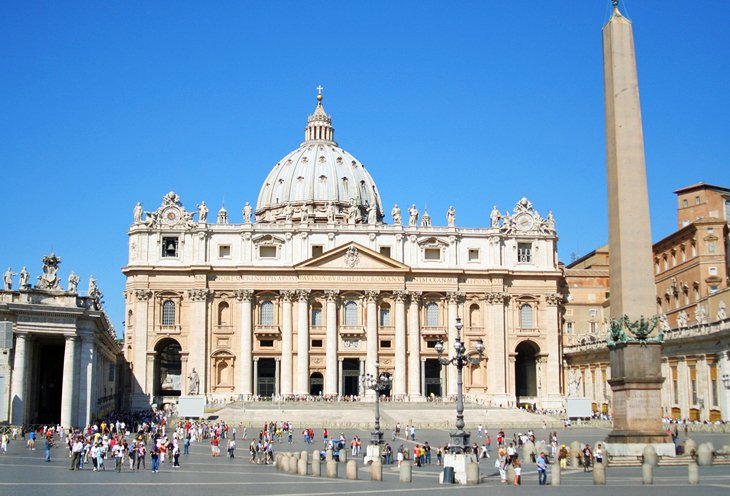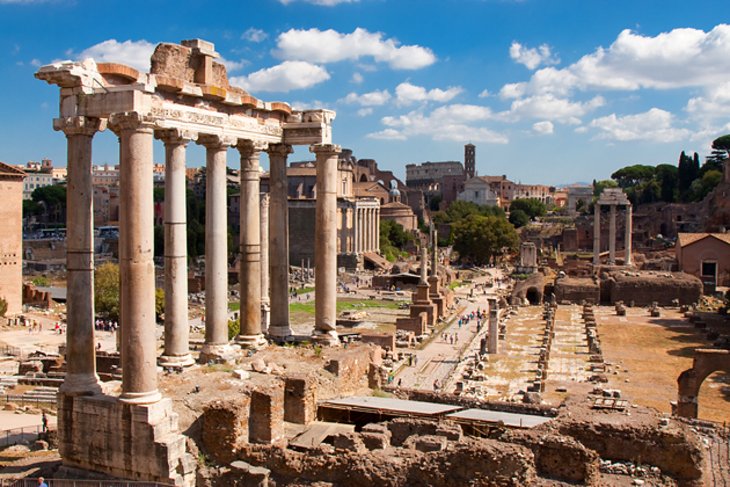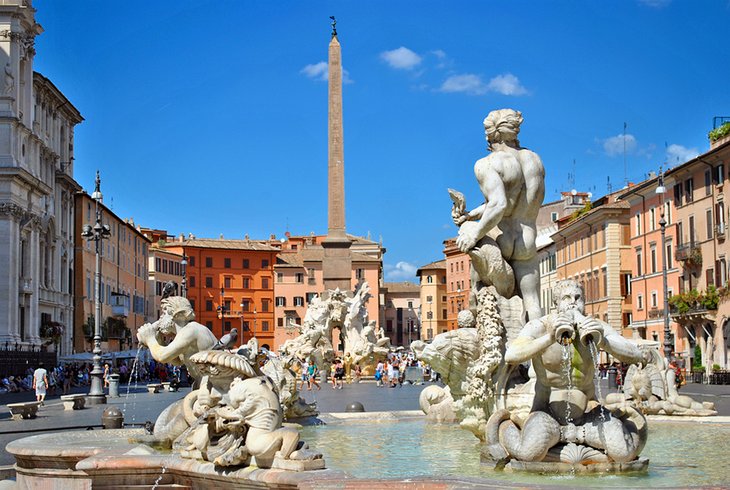Rome is the capital city of Italy. It is also the capital of the Lazio region, the centre of the Metropolitan City of Rome, and a special comune named Comune di Roma Capitale.
metropolitan city in Italy. Its metropolitan area is the third-most populous within Italy. Rome is located in the central-western portion of the Italian Peninsula, within Lazio (Latium), along the shores of the Tiber. Vatican City (the smallest country in the world) is an independent country inside the city boundaries of Rome, the only existing example of a country within a city. Rome is often referred to as the City of Seven Hills due to its geographic location, and also as the “Eternal City”.Rome is generally considered to be the “cradle of Western civilization and Christian culture”, and the centre of the Catholic Church.
In 2019, Rome was the 14th most visited city in the world, with 8.6 million tourists, the third most visited in the European Union, and the most popular tourist destination in Italy. Its historic centre is listed by UNESCO as a World Heritage Site. The host city for the 1960 Summer Olympics, Rome is also the seat of several specialised agencies of the United Nations, such as the Food and Agriculture Organization (FAO), the World Food Programme (WFP) and the International Fund for Agricultural Development (IFAD). The city also hosts the Secretariat of the Parliamentary Assembly of the Union for the Mediterranean(UfM) as well as the headquarters of many international businesses, such as Eni, Enel, TIM, Leonardo, and banks such as BNL. Numerous companies are based within Rome’s EUR business district, such as the luxury fashion house Fendi located in the Palazzo della Civiltà Italiana. The presence of renowned international brands in the city has made Rome an important centre of fashion and design, and the Cinecittà Studios have been the set of many Academy Award–winning movies.
1.The Colosseum and the Arch of Constantine

The Arch of Constantine is a triumphal arch in Rome dedicated to the emperor Constantine the Great. The arch was commissioned by the Roman Senate to commemorate Constantine’s victory over Maxentius at the Battle of Milvian Bridge in AD 312.
The three bay design with detached columns was first used for the Arch of Septimius Severus in the Roman Forum (which stands at the end of the triumph route) and repeated in several other arches now lost.
Though dedicated to Constantine, much of the sculptural decoration consists of reliefs and statues removed from earlier triumphal monuments dedicated to Trajan (98–117), Hadrian (117–138) and Marcus Aurelius (161–180).
As the Eiffel Tower is to Paris, the silhouette of the Flavian Amphitheatre is to Rome. The largest structure left to us by Roman antiquity, the Colosseum still provides the model for sports arenas – present day football stadium design is clearly based on this oval Roman plan.
The building was begun by Vespasian in AD 72, and after his son Titus enlarged it by adding the fourth story, it was inaugurated in the year AD 80 with a series of splendid games. The Colosseum was large enough for theatrical performances, festivals, circuses, or games, which the Imperial Court and high officials watched from the lowest level, aristocratic Roman families on the second, the populace on the third and fourth.
2.Vatican City

Vatican City a city-state surrounded by Rome, Italy, is the headquarters of the Roman Catholic Church. It’s home to the Pope and a trove of iconic art and architecture. Its Vatican Museums house ancient Roman sculptures such as the famed “Laocoön and His Sons” as well as Renaissance frescoes in the Raphael Rooms and the Sistine Chapel, famous for Michelangelo’s ceiling.
Vatican City (/ˈvætɪkən/ (listen)), officially Vatican City State (Italian: Stato della Città del Vaticano; Latin: Status Civitatis Vaticanae), is an independent city-state, microstate and enclave within Rome, Italy.It became independent from Italy in 1929 with the Lateran Treaty, and it is a distinct territory under “full ownership, exclusive dominion, and sovereign authority and jurisdiction” of the Holy See, itself a sovereign entity of international law, which maintains the city state’s temporal, diplomatic, and spiritual independence.With an area of 49 hectares (121 acres) and a 2019 population of about 453, it is the smallest state in the world both by area and population. As governed by the Holy See, Vatican City State is an ecclesiastical or sacerdotal-monarchical state ruled by the Pope who is the bishop of Rome and head of the Catholic Church. The highest state functionaries are all Catholic clergy of various origins. After the Avignon Papacy (1309–1377) the popes have mainly resided at the Apostolic Palace within what is now Vatican City, although at times residing instead in the Quirinal Palace in Rome or elsewhere. The Vatican is also a metonym for the Holy See.
The Vatican is the smallest independent state in the world, with an area of less than half a square kilometer, most of it enclosed by the Vatican walls. Inside are the Vatican palace and gardens, St. Peter’s Basilica, and St. Peter’s Square, an area ruled by the Pope, supreme head of the Roman Catholic Church. This compact space offers a lot of things to see, between its museums and the great basilica itself.
Inside St. Peter’s Basilica is Michelangelo’s masterpiece, Pieta, along with statuary and altars by Bernini and others. The unquestioned highlight of the Vatican museums is the Sistine Chapel, whose magnificent frescoed ceiling is Michelangelo’s most famous work.
3.The Pantheon

The Pantheon is a former Roman temple and, since 609 AD, a Catholic church in Rome, Italy, on the site of an earlier temple commissioned by Marcus Agrippa during the reign of Augustus. It was rebuilt by the emperor Hadrian and probably dedicated c. 126 AD.
The Pantheon – the best-preserved monument of Roman antiquity – is remarkably intact for its 2000 years. This is despite the fact that Pope Gregory III removed the gilded bronze roof tiles, and Pope Urban VIII ordered its bronze roof stripped and melted down to cast the canopy over the altar in St. Peter’s and cannons for Castel Sant’Angelo.
The Pantheon was rebuilt after damage by fire in AD 80, and the resulting brickwork shows the extraordinarily high technical mastery of Roman builders. Its 43-meter dome, the supreme achievement of Roman interior architecture, hangs suspended without visible supports – these are well hidden inside the walls – and its nine-meter central opening is the building’s only light source.
The building is cylindrical with a portico of large granite Corinthian columns (eight in the first rank and two groups of four behind) under a pediment. A rectangular vestibule links the porch to the rotunda, which is under a coffered concrete dome, with a central opening (oculus) to the sky. Almost two thousand years after it was built, the Pantheon’s dome is still the world’s largest unreinforced concrete dome. The height to the oculus and the diameter of the interior circle are the same, 43 metres (142 ft).
It is one of the best-preserved of all Ancient Roman buildings, in large part because it has been in continuous use throughout its history: since the 7th century, it has been a church dedicated to St. Mary and the Martyrs (Latin: Sancta Maria ad Martyres) but informally known as “Santa Maria Rotonda”. The square in front of the Pantheon is called Piazza della Rotonda. The Pantheon is a state property, managed by Italy’s Ministry of Cultural Heritage and Activities and Tourism through the Polo Museale del Lazio. In 2013, it was visited by over 6 million people.
4.Roman Forum

The Roman Forum, also known by its Latin name Forum Romanum, is a rectangular forum surrounded by the ruins of several important ancient government buildings at the center of the city of Rome. Citizens of the ancient city referred to this space, originally a marketplace, as the Forum Magnum, or simply the Forum.
Walking through the forum, now in the middle of a throbbing modern city, is like stepping back two millennia into the heart of ancient Rome. Although what survives of this center of Roman life and government shows only a small fraction of its original splendor, the standing and fallen columns, its triumphal arches, and remains of its walls still impress, especially when you consider that for centuries, the history of the Forum was the history of the Roman Empire and of the Western world.
Roman political and religious life was centered here, along with the courts, markets, and meeting places. After the seventh century, the buildings fell into ruin, and churches and fortresses were built amid the ancient remains. Its stones were quarried for other buildings and it was not until the 18th and 19th centuries that systematic excavations brought the ancient buildings to light from under a 10-meter layer of earth and rubble.
For centuries the Forum was the center of day-to-day life in Rome: the site of triumphal processions and elections; the venue for public speeches, criminal trials, and gladiatorial matches; and the nucleus of commercial affairs. Here statues and monuments commemorated the city’s great men. The teeming heart of ancient Rome, it has been called the most celebrated meeting place in the world, and in all history. Located in the small valley between the Palatine and Capitoline Hills, the Forum today is a sprawling ruin of architectural fragments and intermittent archaeological excavations attracting 4.5 million or more sightseers yearly.
5.Centro Storico & the Spanish Steps

The Spanish Steps in Rome, Italy, climb a steep slope between the Piazza di Spagna at the base and Piazza Trinità dei Monti, dominated by the Trinità dei Monti church, at the top.
Take a look at a Rome tourist map, and you’ll see one area so filled with things to do that it’s hard to read the street names. This is the Centro Storico, the historic center of Rome, with so many art-filled churches, resplendent palaces, and lively squares that you could spend your whole vacation strolling its ancient streets and lanes.
Spend some time just to absorb the neighborhood’s atmosphere instead of going from one of its must-see sights to the next. Along with Piazza Navona, the Trevi Fountain, and the Basilica of Santa Maria Maggiore, stop in less well-known churches, such as Santa Maria del Popolo, where you’ll find works by Bernini and Caravaggio.
The monumental stairway of 135 steps was built with French diplomat Étienne Gueffier’s bequeathed funds of 20,000 scudi, in 1723–1725, linking the Trinità dei Monti church under the patronage of the Bourbon kings of France, at the top of the steps, and the Spanish Embassy to the Holy See in the Palazzo Monaldeschi at the bottom of the steps. The stairway was designed by architects Francesco de Sanctis and Alessandro Specchi.
6.Santa Maria Maggiore

The Basilica of Saint Mary Major, or church of Santa Maria Maggiore, is a Major papal basilica as well as one of the Seven Pilgrim Churches of Rome and the largest Catholic Marian church in Rome, Italy.
One of Rome’s most majestic churches, Santa Maria Maggiore has stood here since the fourth-century Pope Liberius had a vision of the Virgin directing him to build a church where snow fell the following day. Although it was August, snow did fall on the Esquiline hill the next morning, so here the great basilica was built.
Mass has been celebrated here every day since the fifth century. The three aisles of its 86-meter-long interior are separated by 40 columns of marble and four of granite, and the apse added in the 13th century is lined with mosaics of Old and New Testament themes, masterpieces of Rome’s famous mosaic artists.
The basilica enshrines the venerated image of Salus Populi Romani, depicting the Blessed Virgin Mary as the health and protectress of the Roman people, which was granted a Canonical coronation by Pope Gregory XVI on 15 August 1838 accompanied by his Papal bull Cælestis Regina.
Pursuant to the Lateran Treaty of 1929 between the Holy See and Italy, the Basilica is within Italian territory and not the territory of the Vatican City State. However, the Holy See fully owns the Basilica, and Italy is legally obligated to recognize its full ownership thereof and to concede to it “the immunity granted by International Law to the headquarters of the diplomatic agents of foreign States.” In other words, the complex of buildings has a status somewhat similar to a foreign embassy.
7.Piazza Navona

Piazza Navona is a public open space in Rome, Italy. It is built on the site of the Stadium of Domitian, built in the 1st century AD, and follows the form of the open space of the stadium. The ancient Romans went there to watch the agones, and hence it was known as “Circus Agonalis”.
Piazza Navona (pronounced) is a public open space in Rome, Italy. It is built on the site of the Stadium of Domitian, built in the 1st century AD, and follows the form of the open space of the stadium.The ancient Romans went there to watch the agones (“games”), and hence it was known as “Circus Agonalis” (“competition arena”). It is believed that over time the name changed to in avone to navone and eventually to navona.
One of Rome’s most characteristic Baroque squares, Piazza Navona still has the outline of the Roman stadium built here by Emperor Domitian. It was still used for festivals and horse races during the Middle Ages, and was rebuilt in the Baroque style by Borromini, who also designed the magnificent series of palaces and the church of Sant’Agnese, on its west side.
Its facade, campanile, and dome highlight the way Baroque architecture weaves convex and concave surfaces, gables, windows, columns, and piers into a unified design. In the crypt of Sant’Agnese are Alessandro Algardi’s 1653 The Miracle of St. Agnes and the remains of a Roman mosaic floor. Sant’Agnese provided a model for Baroque and Rococo churches in Italy and elsewhere.
Although Borromini designed the square and its surrounding facades, it was his archrival, Bernini, who created its centerpiece, the beautiful Baroque fountain, Fontana dei Fiumi. The spirited fountain represents the four rivers then thought to be the largest on each of the known continents, with figures personifying the Nile, Ganges, Danube, and Rio de la Plata around the large basin, each accompanied by plants and animals of their respective regions.









